Do you believe you can change the world?
That’s the question I asked this morning on Qriously, a new application that measures public sentiment, in real time. It works by replacing ads with questions in smartphone and tablet apps. The application is currently in a closed beta, and I was lucky enough to get access to start playing around with it. It’s so easy to use, and has so much potential for the nonprofit sector, that I couldn’t wait any longer to show it to you!
Qriously is super easy to use: you pick the type of question (two answer, slider, or star/rating), write your question and possible answers, select the location (global, regional or local – if you get a trial account, you are limited to global questions), and then how many answers you want to gather. That’s it!
I’ve run three questions so far, and here’s some of the insights to the process:
What influences your charitable giving?
The first question I asked on Qriously was: “What influences your charitable giving?” and provided the two possible responses of “friends” or “data” – I used the question style where respondents had to pick one answer or the other exclusively. As soon as the question is live, you start seeing the impressions and the responses, aggregated in real time. It’s incredible! You’ll also notice that you can see the impressions, as well as the responses.
And once all 100 responses were gathered, I took a look at all the data.
First, overall:
And when you click on “What does this chart mean?” it actually tells you, with much richer context:
I personally love data-map mashups and Qriously uses them brilliantly! The data on these maps shows the number of responses as well as the direction of response, where orange = “data” and blue = “friends”.
You can start out with a global view:
And drill town to see the data, and let it speak for itself.
What I think is really exciting about this view of the data, is when you can look across a global region and extrapolate on the cultural influences and beyond. Imagine if you were a nonprofit organization, creating a global campaign; you could use a tool like this to test messages and sentiments for various areas around the world to better design and craft the campaign as well as the communications. For example, thinking about the question of what influences giving, look at this section of the map – with exclusive data responses vs friend responses:
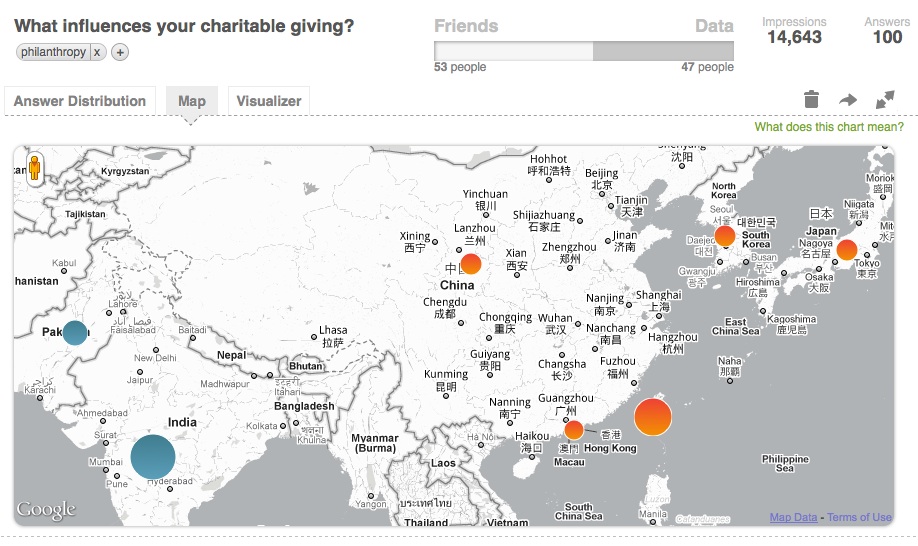 And looking at the US, you can see the changes in response across the states, too:
And looking at the US, you can see the changes in response across the states, too:
Which would you rather give?
The next question I asked was “which would you rather give?” with the answers being “time” and “money” but this time I used the slider question option, meaning respondents have a slider on the screen that they can drag anywhere along the line between the two answers. I thought this would be a good question type to use for this topic because it would let us see not just if one had more “answers” than the other, but if it was an extreme or subtle inclination towards either direction. Here’s the response:
Personally, I agree! I respect and understand the arguement that time is money, but I am able to give more of my time than my money to things that aren’t discrete. I’m happy to share my thoughts, feedback, ideas, and “expertise” and love to help others learn something that they can then do on their own (without me next time). And I often feel that organizations don’t provide a way for me to give, in a way that I think could be valuable, unless it’s financial.
Do you think you can change the world?
That’s right. I asked mobile users around the globe “do you think you can change the world?” and I chose the two-response question type, so they could only answer “yes” or “no”.
And the results? Yes!

Qriously for Nonprofits
I think there are so many potential applications for Qriously in the nonprofit sector!
Marketing
As I noted at the start, the stats provide both impressions as well as responses. So, although you may only have 100 people give you an answer, if your question said, for example, “Have you heard of NTEN?” you have far more people that aren’t responding that still saw your organization’s name.
Listening
Organizations are looking for ways to learn about their community and those they want to reach but haven’t yet. Listening is a big part of social technologies as you can tap into and follow all kinds of conversations. But Qriously offers a way of listening and learning that cuts out the middleman – go straight to the people you want! I’m using a trial account, but full accounts provide the option to target your geography and more.
Targeting
Beyond listening, maybe your organization or campaign needs to identify just who it is that actually is interested! Qriously could be used to test different messages and groups to measure where responses are strongest.
Campaigning
You don’t just have to do market research with Qriously. What if you used the tool as a way of campaigning? The questions could actually be calls to action! For example: “Have you changed to energy efficient light bulbs?” with answers of “I will” and “I did”.
And more!
There are so many ways the social impact sector could put something like Qriously to use – and not just as another shiny toy, but as a tool to meeting our missions.
If you want to check it out for yourself, use this form to apply for Qriously access. Please note that trial accounts only let you ask global questions.
What do you think? I have another question I can ask on the trial account, so please share your suggestions! If you have questions about the application, I’m happy to respond with my experience, or message the Qriously team to weigh in with more information!


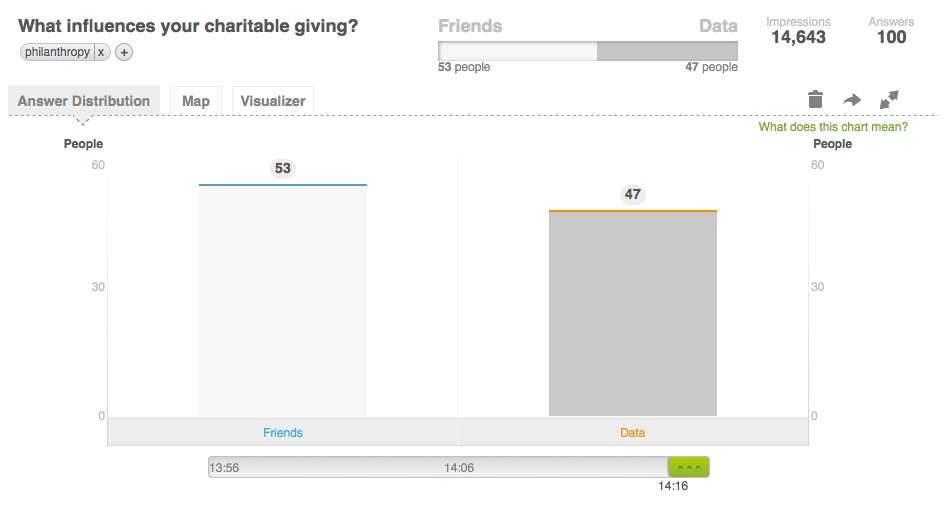

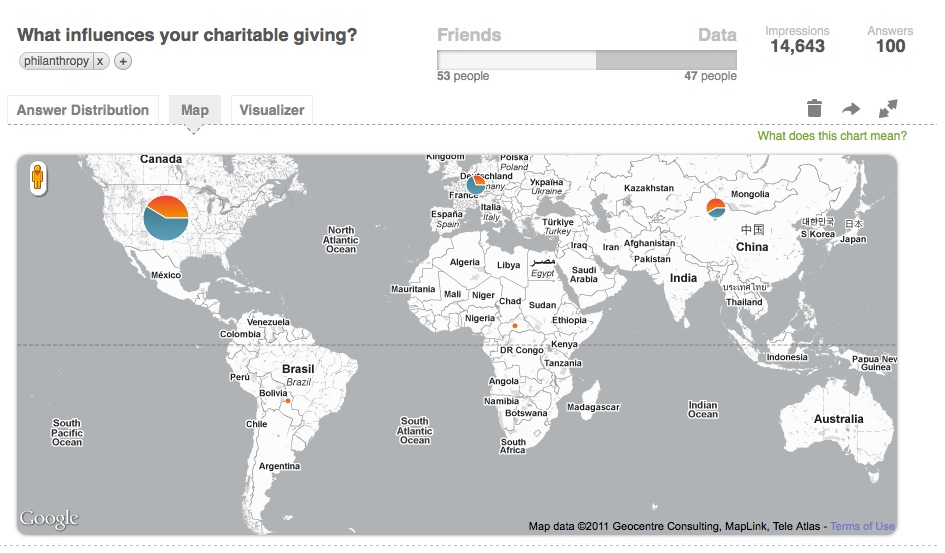

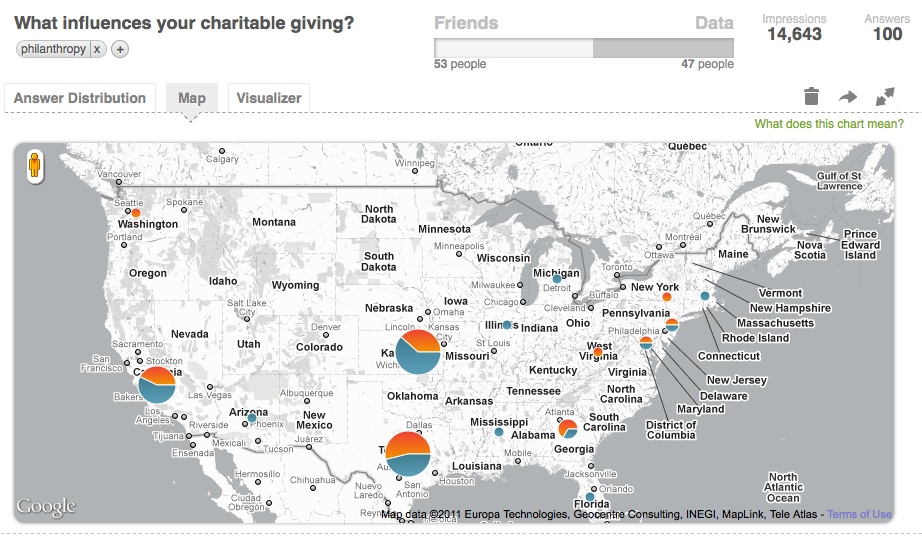
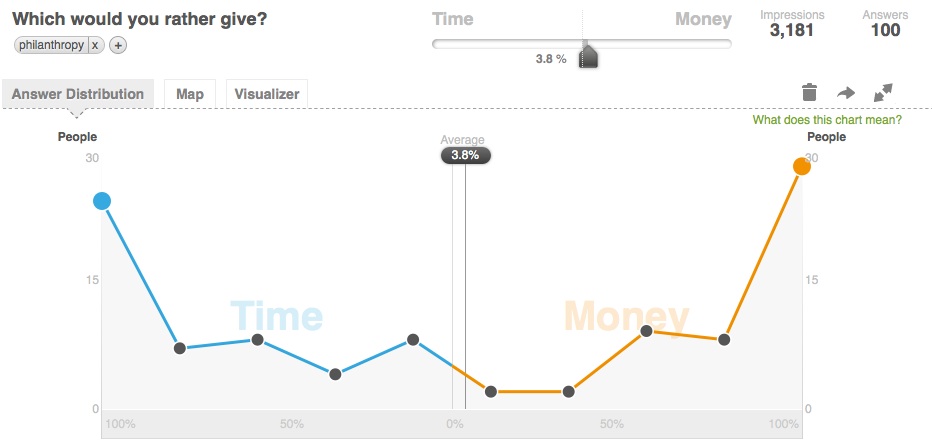
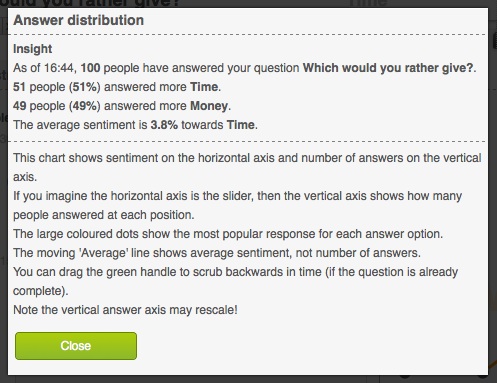

Hi Amy! It’s Adam from Qriously – Thanks for taking such a close look! You are putting to shame my questions about which super power would you want 🙂 If anyone has any builds or thoughts we would love to hear them. Thanks again!
Thanks for joining in here, Adam! I’m having lots of fun testing it out, and
maybe I just can’t thinking outside the box with my questions 🙂
Very very cool, and Amy you rock for providing such a thorough account of how you’ve been experiencing with this so far!!
I have a question about the “take-aways” that are possible from 100 replies. Does Qriously provide resources directly, or provide links to resources, to help users draw appropriate conclusions from the statistics they’re generating? It seems it would be awfully tempting to draw conclusions/generalizations that might not be appropriate for the sampling that’s being done (both the size and cultural/geographical reach). If Qriously isn’t building “analysis add-ons” internally, that’s definitely an opportunity for a third-party app (or two, or three…)…
Christine
Christine – That’s a great question! You can see some of the contextual
guides in the screen shots of the results. But I’m sure that’s a question
Adam can answer – I’ll ping him!
Thanks!
(Adam from Qriously) Hi Christine – great question and thanks Amy for the ping. We haven’t published as much documentation about how to apply the data as we probably should and would love there to be a few external champions to fill in some of the gaps (any takers?). Most of our existing b2b clients are market researchers or consumer insight professionals already so this is clearly something we’ll have to get better at as we come out of closed beta.
I won’t bore everyone to death with measurement science but wanted to offer a few points about polling and lighter forms of market research. I’ll start by saying that there are three big elements to any market research approach: speed, depth of insight and price. Something like Qriously falls in the very fast and low cost spectrum offering directional (lighter) insights. A focus group which has much more granularity takes longer and comes with a much larger price tag. I am sure there are lots of opinions out there about the balance of which approach is right but I’ll offer a few examples of where this type of quick approach might make sense.
For instance, a question that Qriously might answer well for a National organization is around issue sensitivity such as (in honor of our World Wildlife Fund contributor):
How important is wildlife preservation to you?
Answers options: “Not really” AND “Very!”
Or when an organization wants to pre-test a campaign concept:
“WWF: Protecting the Future of Nature”
Answer options: “No way!” AND “Keep the slogan!”
Then you might look at the results where concentrated areas of “for” vs “against” opinions are and better plan your online, TV, radio or in person media efforts. One of the core benefits of a speedy research approach vs a more traditional one is that you can run it throughout a campaign and watch the effect of what you are messaging (then make changes on the fly).
You also asked a great question about sample size or how many people to get responses from. Finding the right sample size to ask or being able to base decisions on a particular response is more subjective than you would think. What I mean is that the number you should ask really needs to tie into how much internal weight you are putting on the number and needs to be a balance for cost. Many times polling style research is used as a compliment or pre-cursor to other more granular types of research like a focus group.
Instead of me pasting everything I thought this site did a neat job of helping you come to the right conclusions: http://www.surveysystem.com/sscalc.htm
Let me know if you have more thoughts or would like to chat via skype.
Thanks!
Adam
Amy, thank you for pinging Adam ~
Adam, thank you *very* much for taking the time to pen such a thoughtful reply. I played with the calculators on SurveySystem, and get the sense that a sample size of 100 wouldn’t generate confident results for any population above 150 or so.
You might already have this idea in your roadmap, or are doing it already: displaying the confidence interval for users after they’ve designed their survey and before the hit “go”. I’m thinking of Priceline saying, “Hm, for a hotel with this star level in this neighborhood, you have a 20% chance of getting the room for that price.”) The difference here is that the quality of the room is the same whether the customer is paying $50 or $500. For Qriously, in many ways, the quality of what is being purchased might be significantly affected by the price.
I see an important obligation to be upfront about that, and am hopeful that you’ll be able to blend full disclosure of WHAT people can measure with Qriously and HOW meaningful those measurements can be. If anything, that disclosure should drive up demand for larger sample sizes and smaller populations, i.e. higher priced – and some would say higher quality – surveys.
Thanks again for the informative comment here and openness to keep the conversation going ~
Christine
Hi Christine – Glad you found the response useful and we will certainly try to include as much documentation including perspective about sample size, great reinforcement. We do have to be a little careful though about dictating how many people is the “right” number to ask or what confidence level is “right” for the decision you are making. What I mean is that not everyone is only doing statistically relevant studies, sometimes as marketers, PR people, Product Managers, etc (not just boring market researchers like me) we just want to get a feel for what people might say or take a quick pulse as a directional insight that lines up with other types of market research. We also have to be realistic that if what I am deciding on his a $1000 campaign I can’t spend more than $50 on measurement etc versus a much larger campaign. Great thoughts all the same, looking forward to keeping the conversation open as well.
Absolutely 100% agreed! I’m so not in favor of dictating, or framing things as right and wrong, either. You’ll get to disclose, articulate, educate, etc. and your customers will get to take all that into consideration as they benefit from the great service you offer. Sounds good to me 🙂
I particularly like that you can see the cultural differences to giving and fundraising (the friends/ data question). This is particularly pertinent for me as a digital marketer at WWF
Thanks, Shanellekari! And, if you want to give it a try, I just posted a
small contest for organizations to win free access:
https://amysampleward.org/2011/04/11/try-qriously-for-free-real-time-data-for-your-organization/
Interesting info. Thanks very much.
This is so cool, I’m definitely applying! Love how you say “I often feel that organizations don’t provide a way for me to give, in a way that I think could be valuable, unless it’s financial.” So true…